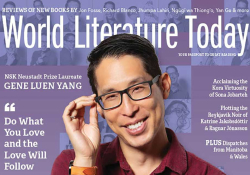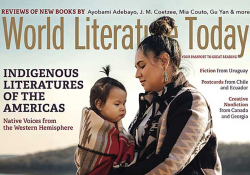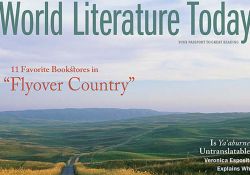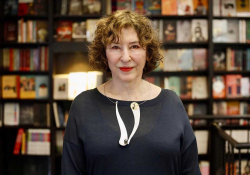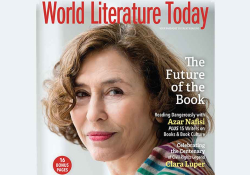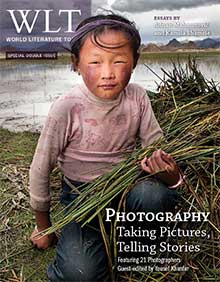Editor’s Note, March 2013
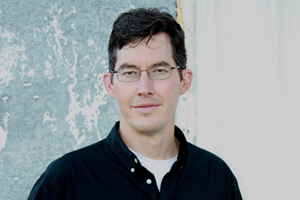
“It’s been said of Picasso that he studies an object like a surgeon dissects a corpse. We want no more of these embarrassing corpses, these objects. Light is all we need.” – Francis Picabia, “Manifeste de l’école amorphiste,” Camera Work, June 1913
Why is World Literature Today, a literary magazine, publishing a photography issue? For one thing, 2013 marks the centenary of popular 35mm still photography: the American Tourist Multiple camera was introduced in 1913, and Oskar Barnack began developing the prototype of the ur-Leica that same year. Moreover, 1913 stands out as a watershed moment in literary and artistic modernism. In February 1913 the legendary Armory Show opened in Manhattan, featuring works like Marcel Duchamp’s Nude Descending a Staircase, No. 2, famously derided by one critic as “an explosion in a shingle factory.” In May, Igor Stravinsky’s ballet, Le Sacre du printemps, caused a near-riot at the Théâtre des Champs-Élysées in Paris. And in November, Marcel Proust self-financed the publication of Du côté de chez Swann, one of the most famous novels of the twentieth century.
That same year, the journal Camera Work (1903–17), published by American photographer, artist, and gallery owner Alfred Stieglitz, was in its prime. From his headquarters at the 291 Galleries on New York’s Fifth Avenue, Stieglitz was busy preparing a special issue of his journal, which championed art photography, in general, and the movement known as pictorialism, in particular. When the issue came out in June 1913, it was less remarkable for its always-elegant black-and-white photography than for its gallery of paintings by the likes of Cézanne, Van Gogh, and Picasso as well as texts by Gertrude Stein and other modernist writers. (The paintings included Picasso’s portrait of Stein, who had sat for him at his Paris studio during the winter of 1905–6.) By juxtaposing photography with other works of modern art and literature, Stieglitz was hoping to promote “the camera’s role as the most apt metaphor for the modernist enterprise,” and to defend the use and aims of photography “as one of the defining tasks of modernism itself” (Caroline Blinder, “Through an American Lens,” in The Oxford Critical and Cultural History of Modernist Magazines, vol. 2).
Now, one hundred years later—and in a similar spirit—WLT presents a special double issue devoted to the language of photography and, by extension, literature. The evolution of photography throughout the twentieth century remains one of the great success stories of the modern era, and the photographers showcased in this issue have all established their reputations over the past fifty years. Magazines have played a vital role in that evolution, from popular illustrated weeklies to avant-garde journals that used photography to visually debate the nature and purposes of art. Many European-born photographers—like Edward Steichen, Alfred Eisenstaedt, and Martin Munkácsi—trained as painters, filmmakers, or photojournalists, then immigrated to the US to work for such celebrated publications as Vanity Fair, Life, and Harper’s Bazaar, inspiring young photographers from Henri Cartier-Bresson to Richard Avedon.
Writers, in turn, have long been influenced by the formal possibilities embodied in photography. After the daguerreotype was first introduced in 1839, poets, in particular—for centuries captivated by the arts of sculpture, music, architecture, and painting—found a new muse in photography. In 1840 Edgar Allan Poe wrote: “The instrument itself must undoubtedly be regarded as the most important, and perhaps the most extraordinary, triumph of modern science.” Poe would sit for at least six daguerreotypes throughout the 1840s, and some of the most famous early portraits were Nadar’s prints—from wet collodion negatives—of Baudelaire and Gauthier in the 1850s. In his 2011 study, L’occhio della Medusa, Remo Ceserani cites over four hundred novels in which photography plays a role. And in an essay commissioned for this issue, “The Missing Picture,” Pakistani novelist Kamila Shamsie reflects on writing the story a photograph purports to tell and, sometimes, the one it doesn’t.
La lumière nous suffit. – Francis Picabia
Throughout the twentieth century, famous photographers captured portraits of world-renowned writers—my favorites include Edward Steichen’s Eugene O’Neill, Edward Weston’s D. H. Lawrence, Walker Evans’s Hart Crane, Philippe Halsman’s Nabokov, Henri Cartier-Bresson’s Faulkner, Robert Capa’s Hemingway, Richard Avedon’s García Márquez, Elliott Erwitt’s Kerouac, and Annie Leibovitz’s Alice Walker. (Not to mention Capa’s photo of Picasso and Françoise Gilot, which was hanging in my wife’s apartment when we first started dating.) One of the most remarkable collections of contemporary author portraits can be found in Nancy Crampton’s Writers (2005). Of course, there’s also a Pinterest page that includes playful portraits of musicians, writers, and artists.
Reading through the photographers’ essays that accompany each of the image galleries in this issue, it’s clear that many of them think of photography in linguistic terms. “The photograph to me is a language at many levels,” writes Robert Glenn Ketchum, one of the twenty-one photographers included here. “A great still image is also a work of poetry. The best pictures resonate a beautiful rhythm in their description, much like the line of a finely written sentence or poem.” Similarly, Lois Greenfield describes photography’s “inherent visual syntax” as being “analogous to language,” while Ami Vitale imagines herself to be “crafting a story” even as she fires the shutter. Throughout this double issue, photographers set aside their cameras to speak about their craft—how they conceptualize photography as a language, composing visual stories or “pixel poetry,” in Ketchum’s phrase. At the same time, the accompanying galleries of images enact their visual aesthetic on the page.
By the conventional measure, the seventy-plus pictures included in this issue must be worth more than seventy thousand words. And while photographers often prefer to let the images they create stand on their own, without comment, in this instance we’re fortunate to have their words alongside their photos. Our hope is that the current issue of WLT will spark interest in the many intersections of literature and photography, highlighting their ways of seeing—and speaking for—the world.
Daniel Simon
N.B. I owe a deep debt of gratitude to Yousef Khanfar, our guest editor for the photography section, for his visionary work on this issue, which dates back more than two years. Yousef has long been one of WLT’s most ardent supporters—he dedicated hundreds of hours to bring this project to fruition, and his passion for the topic is everywhere apparent in these pages. His foreword to the special section appears here, and you can view portfolios of his work on his website, www.yousefkhanfar.com.
Recommended Reading
Roland Barthes, Camera Lucida: Reflections on Photography (Hill & Wang, 2010)
Karen Redrobe Beckman and Liliane Weissberg, eds., On Writing with Photography (University of Minnesota Press, 2013)
François Brunet, Photography and Literature (Reaktion, 2009)
Peter C. Bunnell, ed., Aperture Magazine Anthology: The Minor White Years, 1952–1976 (Artbook/D.A.P., 2012)
Mark Durden, Fifty Key Writers on Photography (Routledge, 2012)
Walker Evans, American Photographs, 75th anniversary edition (Museum of Modern Art, 2012)
Mick Gidley, ed., Writing with Light: Words and Photographs in American Texts (Peter Lang, 2010)
Allen Ginsberg interview with Thomas Gladysz, in Spontaneous Mind: Selected Interviews, 1958–1996, ed. David Carter (HarperCollins, 2001)
Jonathan Green, ed., Camera Work: A Critical Anthology (Aperture, 1973)
Brooks Johnson, ed., Photography Speaks: 150 Photographers on Their Art (Aperture, 2004)
Beaumont Newhall, ed., Photography, Essays and Images: Illustrated Readings in the History of Photography (Museum of Modern Art, 1980)
Lise Patt, ed., Searching for Sebald: Photography After W. G. Sebald (Institute of Cultural Inquiry, 2007)
Lisa Pearson, ed., It Is Almost That: A Collection of Image + Text Work by Women Artists and Writers (Siglio, 2011)
Susan Sontag, On Photography (Penguin, 2008)
Gabriele Stabile and Juliet Linderman, Refugee Hotel (McSweeney’s Books, 2012)
Will Steacy, ed., Photographs Not Taken (Daylight, 2012)
